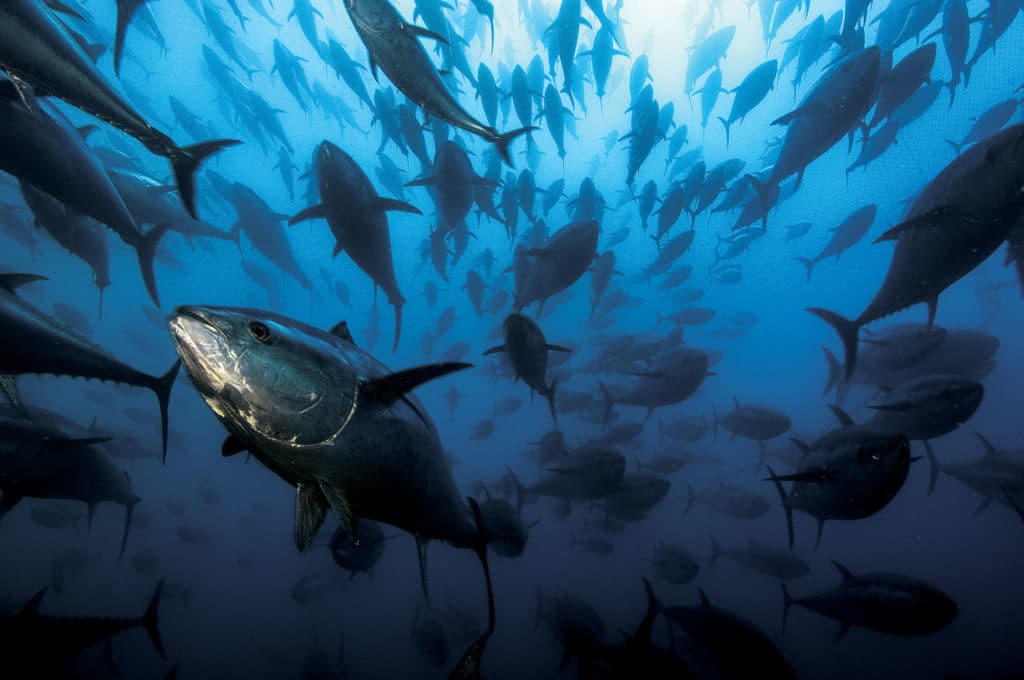
NGS Picture Id:1055393
It was a slow summer at Hudson Canyon off New York, but we were going in any case, because you can’t catch tuna when you’re dry on the dock. We weren’t halfway out when we saw life—a half-dozen whales rolling, and tails rising among what must have been 100 or more tightly packed bottlenose dolphin. Dozens of shearwaters flocked around the commotion. Extending outward for 100 square yards, storm petrels dabbed the blue 75-degree surface waters. The sonar screen read 180 feet. Something was up.
One cast into the mayhem created instant action. As soon as the bail closed, a fish grabbed the lure, and the rod doubled over at an impossible angle. Line easily peeled off the reel against a good 30 pounds of drag. The mate looked over at me with a big smile on his face and said, “Well, I guess we’re not going to the canyon.”
Running way offshore for big pelagics is ingrained. Want to catch tuna? Hit the “deep,” the “edge,” the canyons. And whether you see life or empty ocean, deploy a spread and troll blindly for hours.
But in recent years, most of the good fishing has occurred well inshore of the canyons, and trolling isn’t required.
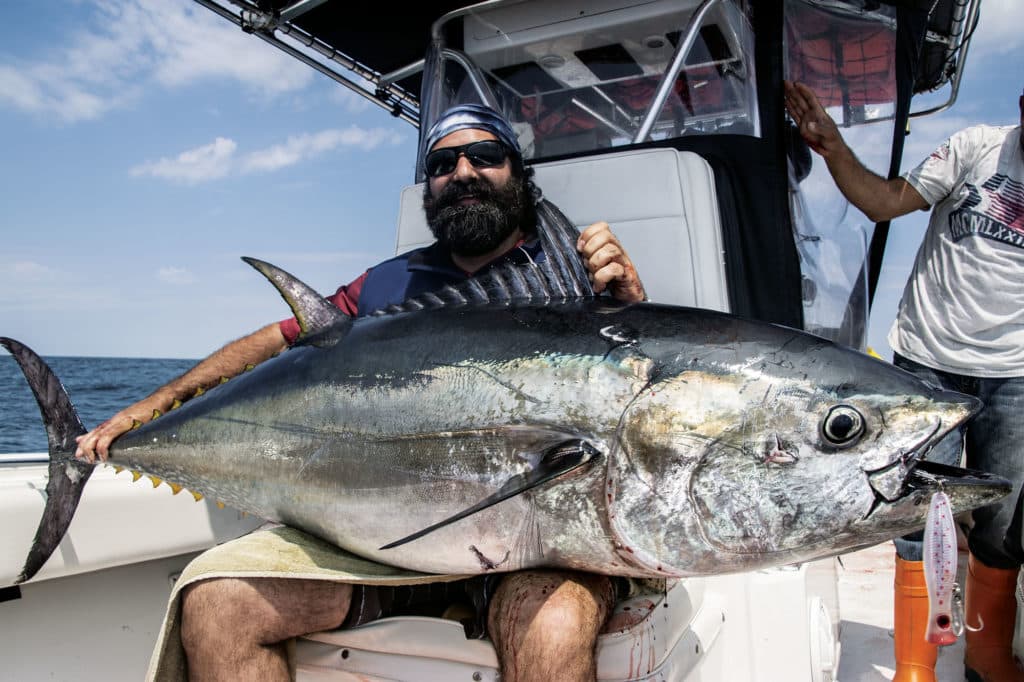
All About That Bait
We owe this success to one thing, and one thing alone: sand lances, Ammodytes americanus (known locally as sand eels)—long, slender, 6- to 8-inch low-trophic-level fish with a pointy snout.
During the past six or seven years, when the sand eels have shown up—usually by mid-June—they’ve appeared in extraordinary numbers. Anglers know about it pretty quickly because often the entire list of oceanic predators also find them. Not just those with fins, but those with wings as well. Everything appears to eat sand eels.
To be clear, this bait does not reside in deep water. As the name suggests, sand eels prefer relatively sandy habitat in 40 fathoms or shallower. They also burrow at night into the soft substrate and spend their days feeding on zooplankton. They’re not equipped to frequent deep, high-pressure water, thus don’t expect to see big concentrations at the canyons.
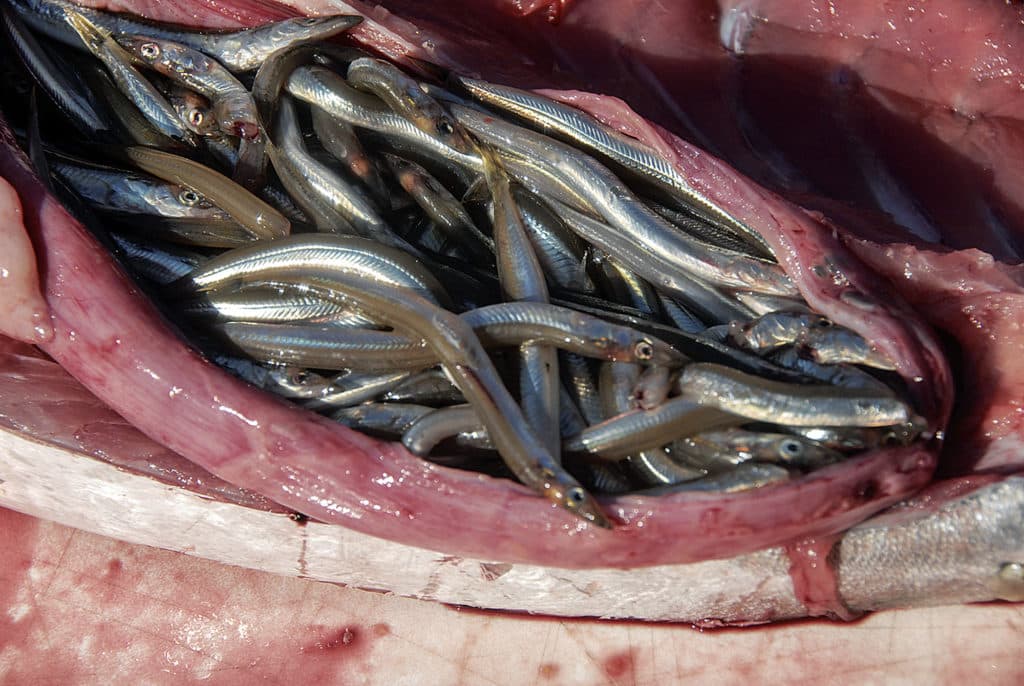
Why do they gather, and why recently have they flooded the 20- to 40-fathom area from Maryland to New York from mid-June to mid-September? Those are more-difficult questions to answer, but it seems likely that the mass migration involves a food source. Adult and larval sand lances feed primarily on copepods (immature crustaceans) and other tiny animals, so they might be focused on a new zooplankton bloom.
Regardless of the reason, the sand eels now congregate so thickly that once you’re into them, you often can’t read bottom on your sounder. And it’s clear that when they’re abundant, they attract a host of predators—most important of which are bluefin and yellowfin tuna—that gorge on the smallish baits with reckless abandon.
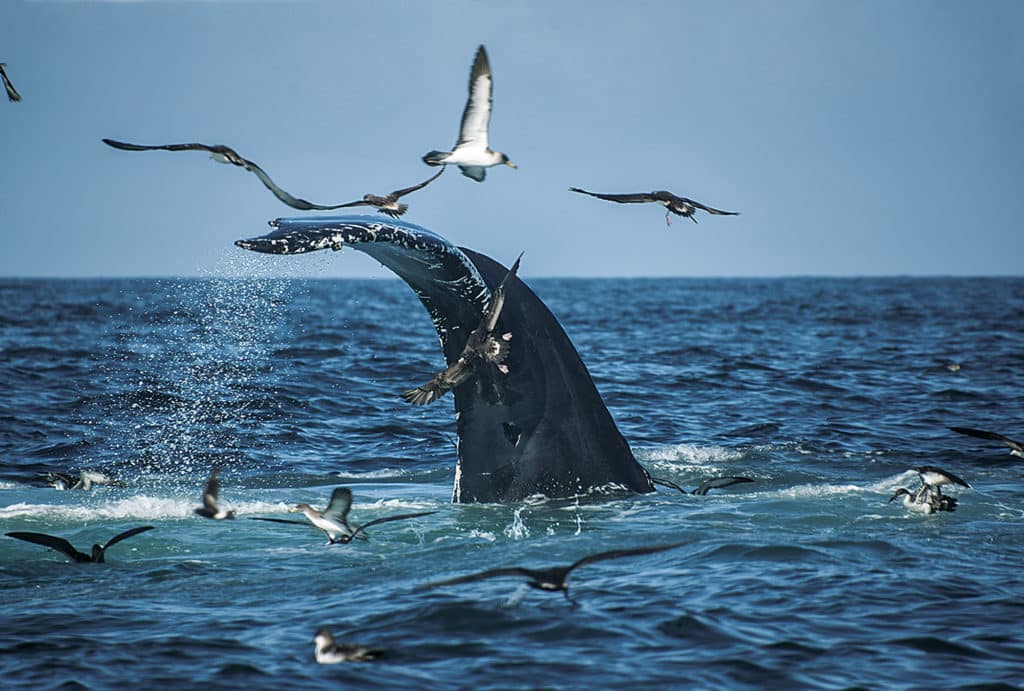
Location Indicators
“It’s all about finding life when you make these midshore tuna runs,” says New Jersey charter captain Gene Quigley (shorecatch.com). “I’d say we look for whales more than anything, but there are certainly other indicators.”
Not only do whales and tuna feed on this same prey, but both bluefin and yellowfin tuna often swim directly beneath the whales, possibly slurping up stunned sand eels after a whale has lunge-fed.
“We look for [bottlenose] dolphin too,” Quigley continues. “Not just the rolling ones, but the ones that are clearly smashing sand eels.”
Finding cow-nosed rays in 150 to 200 feet of water in July or August might be one of the best tuna signs. “Man, you run across a school of cow-nosed rays, and you’re a fool not to stop on it,” says New York captain Cory Crochetiere (nycflyfishing.com). “Drop a jig under them, and it’s often an immediate hookup.”
On a clear, calm day, you can see rays pushing water when they’re on the surface. But often they swim 10 feet or more down. When they pass under your boat, they’re easy to see. For better or worse, rays also hit a jig or soft plastic.
Rays often appear accompanied by storm petrels, or what we call “tuna chicks”—small unassuming birds that seem to dance on the water. Just the presence of these birds, with or without the rays, can indicate sand eels, and subsequently tuna.
The petrels clearly don’t feed on sand eels. More likely they’re eating the same planktonic animals as the sand eels. A mother lode of storm petrels signals a mandatory stop, but even if you see just a half-dozen, give it a try. “We had our largest bluefin last year, casting a stickbait at a flock of what was maybe six or seven tuna chicks,” Crochetiere says. “A 250-pound-class bluefin came out of nowhere and crushed the plug.”
Shearwater birds also can suggest the presence of sand eels. If you see shearwaters circling high above the water, make a stop. They might be seeing something that you can’t, such as big pods of sand eels or even cruising tuna.
While you’ll likely see such life fairly close to shore, inside 20 fathoms, you probably won’t see tuna, at least during the June-to-September period. We really don’t stop on anything inside 20 fathoms, unless we see obvious signs of tuna feeding. Generally, we find the sweet spot in the 30-fathom range, more specifically in 150 to 200 feet of water.
However, even in that depth range, if the water looks green or dirty, most of the time we just move. You occasionally might find bluefin in less-than-blue water, but rarely yellowfin. Look for sand eels in cobalt-blue offshore water. That doesn’t guarantee tuna, but work the area. Nearby tuna eventually will find that bait.
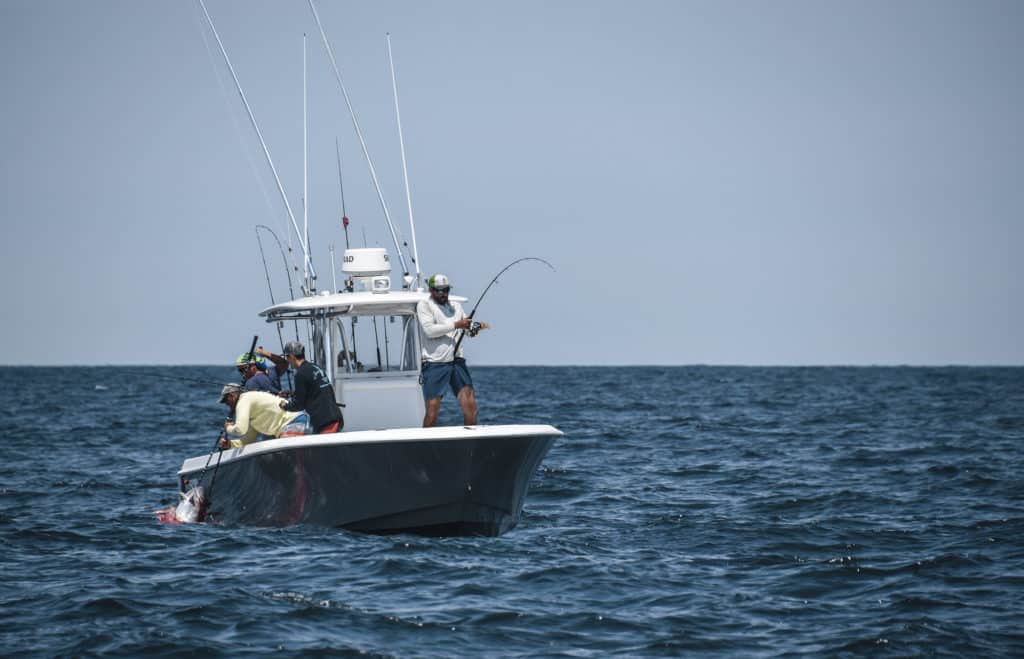
Serious Gear
We fish these sand eel aggregations with soft-plastic and hard baits, using stout spinning tackle. Our favorite reels include Van Staal’s VSB250, Shimano’s Stella 18000 and 20000, and the Daiwa Dog Fight Saltiga 8000. For a more affordable alternative, try the Quantum Cabo 120.
Reels should be spooled with at least 80-pound braid and 6 to 10 feet of 80- to 125-pound fluorocarbon leader.
Rods must be specific to the tuna-popping-and-jigging game as well. Popping rods measure 7 feet, 6 inches to 8 feet, 4 inches long (casting distance is important), and they should be strong in the butt section for extended fights and real lifting power. Favorites include the Centaur and Race Point by Saltywater Tackle.
Rods to fish soft plastics, such as RonZs, can be shorter, at 6 to 7 feet, but they should demonstrate the same parabolic composition. Madd Mantis makes an affordable 7-foot all-around rod.
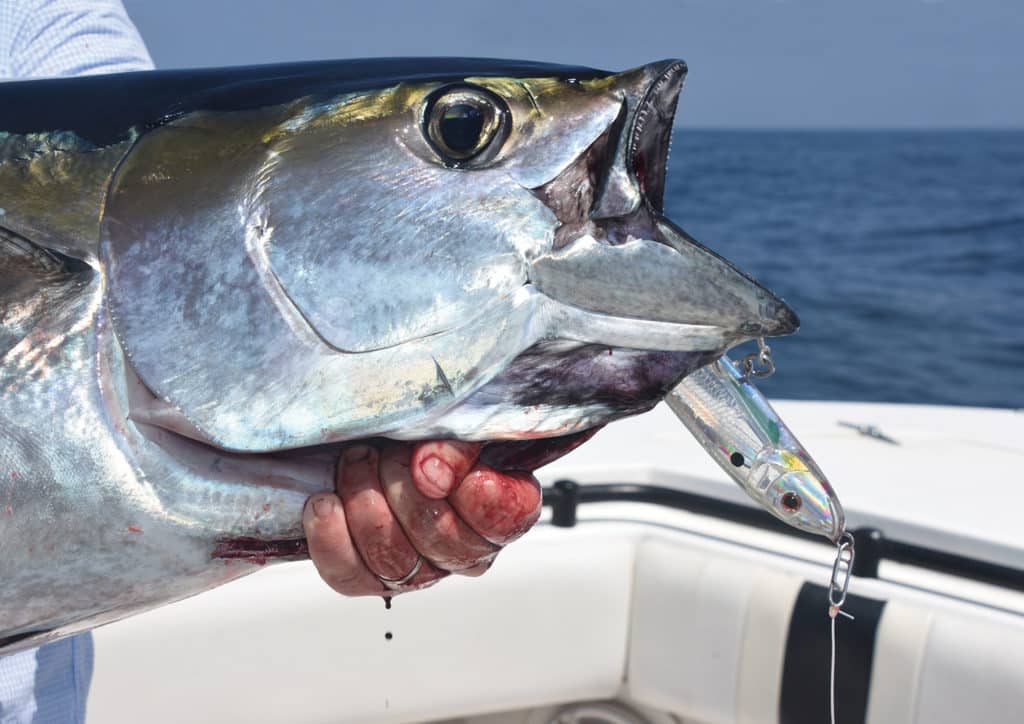
June and July Bluefin
Sand eels usually start to show in the 30-fathom range by mid-June. “It’s generally a water-temperature thing,” says noted New York offshore angler Ray Phelan. “Right around 65 degrees, we start to see them, and they get more abundant as things warm.”
Late spring also marks the appearance of larger (for spin-fishermen) bluefin in the 200-plus-pound category. Moving into July, the bluefin become more manageable in size—in the 80-pound range.
“Yeah, we get a few on poppers and stickbaits,” Crochetiere says, “but during the past couple of years, the shearwaters were so bad that you’d waste valuable time untangling birds. Most of the fish we catch [when that happens] are on RonZ soft-plastic baits.”
The 10-inch RonZ tails come rigged with a 500-pound Krok swivel eye, 500-pound through-wire, and a 9/0 Gamakatsu HD live-bait hook. Not only does the bait move easily side to side on the swivel in an articulated fashion, but the connection is super strong. You might experience tackle failures fighting tuna, but they won’t involve this lure.
The soft-plastic tail wiggles so easily that you won’t have to impart much action to make it resemble a sand eel. Even when working this bait very slowly, it still features a ton of movement. “Tuna will often grab it on the drop,” Crochetiere says. “And we’ve certainly caught fish just dead-sticking them,” or, leaving the rod in the holder.
We’ve learned over the years that bluefin like a slow bait presentation. Even with plugs, a long, slow retrieve draws way more strikes than a fast one.
Once you get the RonZ below the surface, avoiding a shearwater attack, it works really well. Yes, metal jigs can and do work, but not as well as these 10-inch soft plastics.
When the birds abate, Crochetiere mixes in some poppers and stickbaits such as the Nomad Riptide. This 200 mm (8-inch) translucent floating stickbait features a single strip of reflective tape on its sides, and closely mimics a sand eel. Work this bait in a slow, sweeping fashion. Other effective plugs include the Siren Deep Seductress, Shimano Orca and Daiwa Slider.
“Poppers are pretty awesome too, if for no other reason than the often-violent blowups,” Crochetiere says. His popper choice: the Madd Mantis Atasi. “Not so easy to find anymore, but there’s something about this plug that draws crazy strikes.”
Late-Summer Yellowfin
By late July or early August, you might catch a yellowfin while targeting bluefin in that same, general 30-fathom range. And then, in what seems like the span of a few hours, the bluefin can disappear, presumably shooting up to New England and farther north.
“I’m not sure if it’s a temperature change, or it’s just that so many yellowfin show up that they push the bluefin out,” Quigley says, noting that the water warms to 74 or 75 degrees in midsummer.
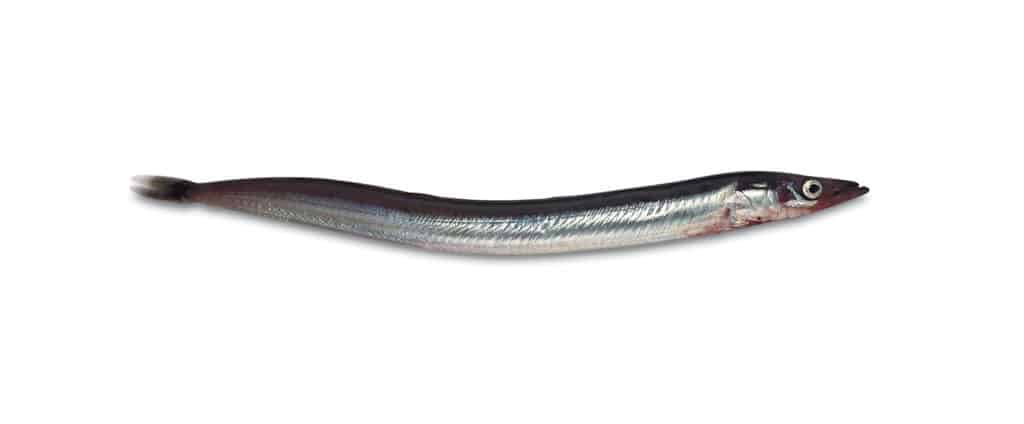
In 2017, the Mid-Atlantic Fishery Management Council moved to protect forage species currently not managed under any existing fishery-management plan by putting landing caps in place that would prevent large-scale harvest of critical forage resources. While a host of forage species received this protection under the council’s Unmanaged Forage Amendment, council members singled out sand eels as having great ecosystem value as a low-trophic-level (bottom-of-the-food-chain) species, noting their value in transferring energy from phytoplankton up to top marine predators such as tuna. The council initiated this amendment in light of rumors that large-scale commercial boats were gearing up to prosecute a fishery on sand eels, which would have seriously altered the mid‑Atlantic and New England ecosystems. Capt. John McMurray
The bait doesn’t change, however; the sand eels continue to swarm. Fishing yellowfin on sand eel aggregations remains similar to targeting bluefin, with a few nuances. Yellowfin seem to swim with the dolphins to a greater extent than the bluefin. A popper placed in front of a school of feeding dolphins often results in an explosive strike from an 80-pound tuna. Cow-nosed rays also dependably indicate nearby yellowfin; the fish often swim directly underneath the rays.
Unique to yellowfin, however, are the skipjack schools. “We have a lot of success throwing big poppers in those skipjack schools,” Quigley says. “The big yellowfin come up from underneath all those skippies and hammer them.”
I don’t think the yellowfin eat the skipjack. Both species seem to feed on the sand eels. Almost every time we clean a yellowfin, we find a stomach packed full of eels, but no skipjack.
Read Next: Bluefin Tuna Blitz Behind the Scallop Boats
Sand eel fishing for tuna winds down in September mainly because the weather worsens and the water cools. Yellowfin, in particular, begin to migrate to deeper water.
The eels do remain, and anglers can fish another brief run of bluefin in December as the tuna head back south. During that time, fishing occurs in much shallower water closer to shore. But that’s its own unique and extraordinarily difficult fishery, requiring its own article.
For summer tuna, remember that farther might not always be better. Think twice about running long, or at least keep your eyes open on the way to the deep. Find the life, and you might score big without burning all that fuel.
About the Author
Capt. John McMurray is owner/operator of One More Cast Charters in Oceanside, New York, as well as the president of the American Saltwater Guides Association—a coalition of professional guides promoting better business though conservation.








